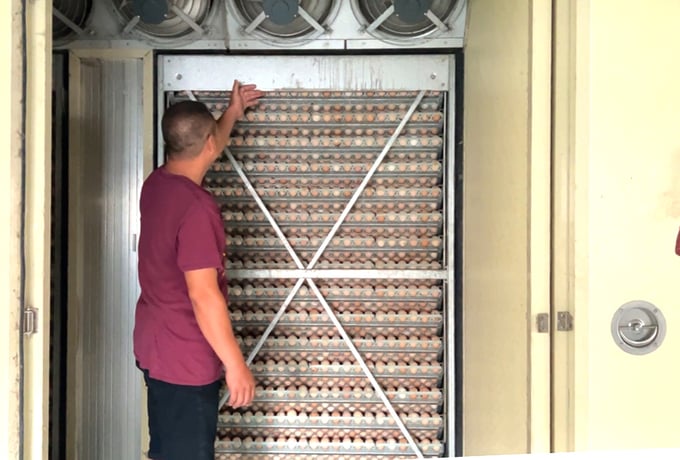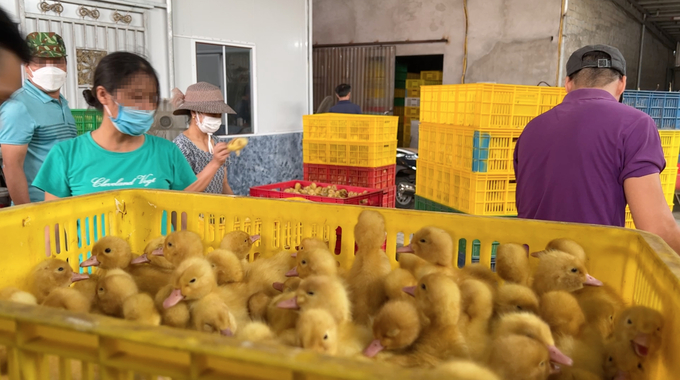June 2, 2025 | 03:08 GMT +7
June 2, 2025 | 03:08 GMT +7
Hotline: 0913.378.918
June 2, 2025 | 03:08 GMT +7
Hotline: 0913.378.918
According to Mr. Nguyen Thanh Son, Chairman of the Vietnam Poultry Association, many domestic poultry breeding enterprises recently had to reduce their flocks by 50-60% because they could not bear the loss when selling chicken and duck breeds below production cost. Even FDI enterprises with strong potential have had to cut their stock by 20-30%.
One of the important causes leading to the above tragedy is the problem of illegally importing poultry breeds from abroad across the border into Vietnam, which has become complicated and has increased recently.

Mr. Nguyen Thanh Son - Chairman of the Vietnam Poultry Association and former Director of the Institute of Animal Husbandry (Ministry of Agriculture and Rural Development), discussed with Vietnam Agriculture Newspaper the problem of illegally importing poultry breeds from abroad across the border into Vietnam. Photo: Hung Khang.
Sir, after following the series of investigative reports "Illegal poultry breeds disrupt the livestock industry" of Vietnam Agriculture Newspaper and listening to the feedback of businesses in the industry, how do you perceive the consequences of smuggled poultry breeds flooding into Vietnam?
First, we very much welcome and appreciate the quick intervention of Vietnam Agriculture Newspaper in reporting the smuggling of poultry breeds and poultry products from abroad into Vietnam through a series of investigative articles recently.
It can be said that information from the investigation articles has reflected part of the iceberg about the complex livestock and poultry smuggling activities that have been taking place in recent times, creating a multi-dimensional view for readers and providing timely information for authorities to intervene quickly.
The situation of illegally importing poultry and poultry products into our country has negatively affected the livestock industry. First, this is one of the reasons that disrupts the domestic livestock market, creating unfair competition. On the other hand, it also causes long-term consequences for the livestock industry.

Many domestic breed hatcheries have been in trouble for a long time because the price of the breed sold is below production costs. Photo: Hung Khang.
Smuggled chicken and duck breeds of unknown origin led to the intrusion of highly virulent strains of the avian influenza virus and other dangerous infectious diseases from abroad into Vietnam.
The death rate is high because smuggled breeds are not quarantined, not vaccinated, and infected with many pathogens. Many imported breeds get sick and die after 1-3 months, causing farmers heavy losses and reducing production.
In particular, poultry breeding facilities have suffered heavy losses due to being unable to sell the breed, and many businesses and farms are forced to reduce their herds or not reherd. "Big men" in the poultry industry, such as C.P. Vietnam Joint Stock Company or Japfa had to reduce their herds by 20 - 30%. Many domestic businesses also had to reduce their herds by 50-60%.
Sir, sometimes a chicken breed is smuggled across the border and transported to Hai Duong for only VND 8,000/chicken. Why are the prices of smuggled poultry breeds so low?
There are several reasons why Chinese chicken breed prices are low. Firstly, these breeds are not quality controlled and are not vaccinated against diseases (to reduce costs and create a competitive price advantage). Second, some, like the Chinese breed, separate the female to keep the eggs. The males are eliminated, sold as cheaply as giving away, and even sold regardless of price. Traders buy it and then try to transport it to Vietnam to make a profit.
After selling the breed to consumers, they deny responsibility, let the breeders live and die, do not "warranty" the breeders if the chickens or ducks get sick and die, or do not guarantee quality as advertised.
In late August and early September, authorities in some localities bordering the Vietnam-China border, such as Lang Son and Quang Ninh, detained shipments of poultry breeds of unknown origin. So, does that result reflect the actual scale and complexity of the situation of poultry breeds smuggled into Vietnam?
Recently, cases of transporting smuggled poultry breeds have been seized by the authorities in Quang Ninh and Lang Son. Still, the volume is only minimal compared to the large number of smuggled poultry breeds and poultry products every year and does not reflect the true nature, scope, and scale of large livestock and poultry smuggling rings that have been going on for a long time in many localities, especially in border provinces.

Thousands of Chinese ducks were smuggled in by a facility in Ninh Giang district (Hai Duong) to supply agents in many northern provinces and cities. Photo: Hung Khang.
On May 18, 2023, Prime Minister Pham Minh Chinh signed Official Dispatch No. 426/CD-TTg on preventing, detecting, and strictly handling cases of illegal trading and transporting poultry across the border into Vietnam. Vietnam. The Ministry of Agriculture and Rural Development also issued an Urgent Telegram No. 1030 dated February 26, 2023, requesting the Chairman of the People's Committees of provinces and centrally run cities to strengthen the fight and prevent poultry from being smuggled into Vietnam.
After the Prime Minister's Directive No. 426, we saw the situation of smuggled poultry breeds calm down for a while. Still, things calmed down, and now the smuggling of poultry breeds is becoming very complicated.
Suppose the above situation continues and authorities from central to local levels do not have effective solutions to prevent the smuggling of poultry breeds. In that case, the livestock industry will gradually die and eventually die completely.
In your opinion, what are the immediate and long-term solutions to prevent the illegal import of poultry breeds shortly?
It is necessary to affirm that preventing and combating livestock and poultry smuggling is a long-term "battle" and must be carried out regularly and continuously. It cannot be organized in a "campaign" style. Therefore, synchronized solutions are needed.
First of all, it is the responsibility of local authorities, directly the Steering Committee 389, to strengthen inspection and supervision, especially at border gates, trails, and openings in seaport border areas and riverways, to promptly detect and prevent illegal trading, slaughtering, and transportation of poultry and poultry products into Vietnam.

Chinese chicks are raised from 1-day-old chickens at a farm in Ninh Giang district, Hai Duong province, before being sold to business agents at the Dai Xuyen poultry wholesale market area (Phu Xuyen district, Hanoi). Photo: Hung Khang.
Second, the authorities need to set up a special project to investigate those who trade and transport smuggled poultry and poultry products across the border, as reported by Vietnam Agriculture Newspaper, and then take measures to strictly handle violating organizations and individuals. On the other hand, it is necessary to promote communication work and regularly educate people about the harmful effects of trading, transporting, and using poultry and poultry products that are not quarantined and of unknown origin.
In particular, border localities and inland localities, such as Hanoi, Hai Duong, Bac Giang, and Bac Ninh... also need to be strong with poultry products and poultry of unknown breeds. origin, not quarantined. Because these smuggled products are mainly consumed in the Northern and Central provinces, the problem lies in whether these localities know or do not know and whether they take drastic action.
Translated by Tuan Huy

(VAN) Several scientists and farmers are experimenting with soil treatment in some key durian-growing regions such as Cai Lay (Tien Giang), Dak Song, Gia Nghia, and Dak R’lap (Dak Nong).
/2025/05/25/4127-3-073637_820.jpg)
(VAN) Thanks to the promotion from an FAO-implemented project, vegetable production in greenhouses in Moc Chau has seen strong development, from 1.5 hectares in 2021 to nearly 50 hectares in 2024.

(VAN) FAO has recently supported USD 140,000 to implement the project 'Risk mitigation human-animal interface risks through disease control initiatives in pig farming.'

(VAN) The People's Committee of Tra Vinh province has approved an adjustment to the investment policy for the Green Hydrogen Plant project, increasing its area to approximately 52.76 hectares.
![Reducing emissions from rice fields: [2] Farmers’ commitment to the soil](https://t.ex-cdn.com/nongnghiepmoitruong.vn/608w/files/news/2025/05/05/dsc08881jpg-nongnghiep-140632.jpg)
(VAN) Clean rice cultivation model in Thuong Tan commune, Bac Tan Uyen district, is assisting local residents in achieving sustainable agriculture by substantially reducing costs, increasing productivity, and protecting the environment.

(VAN) At the conference to disseminate Resolution No. 68, AgriS introduced its digital agricultural ecosystem and reaffirmed its commitment to accompanying the Government in promoting private sector development and sustainable agriculture.

(VAN) 'Blue Ocean - Blue Foods' initiative is designed to restore marine ecosystems and establish sustainable livelihoods for local communities by cultivating a minimum of 1,000 hectares of cottonii seaweed in the first three years.